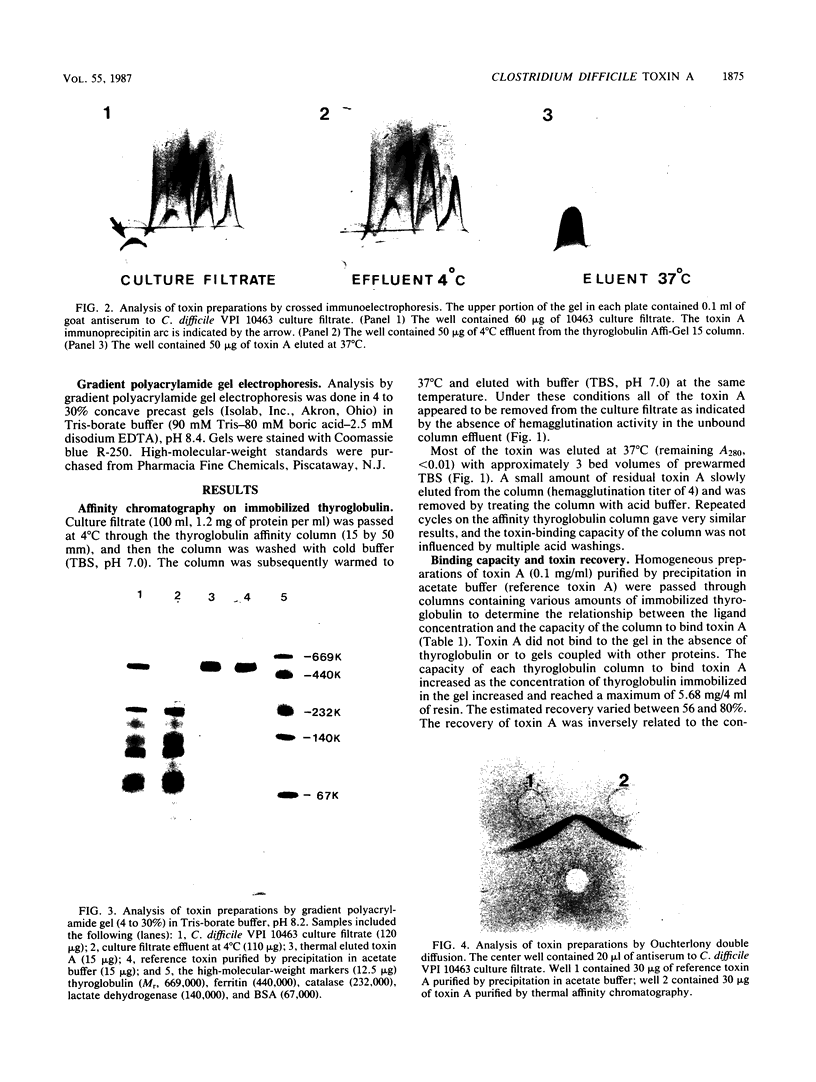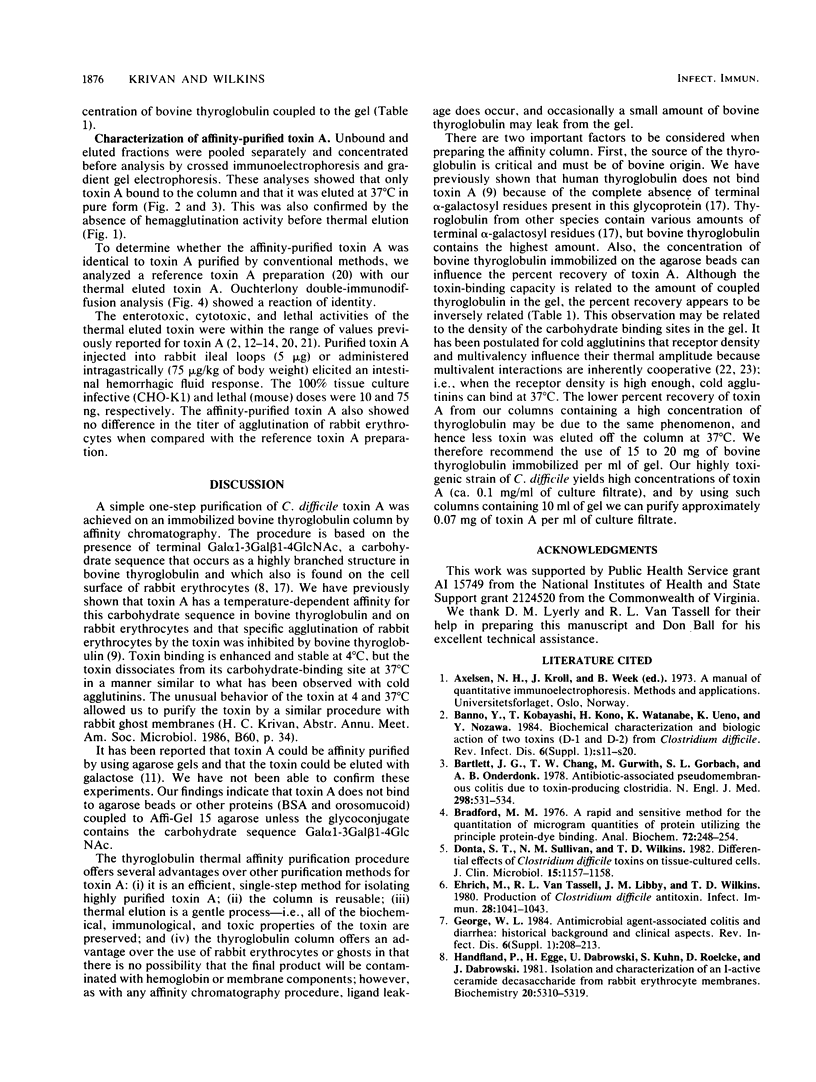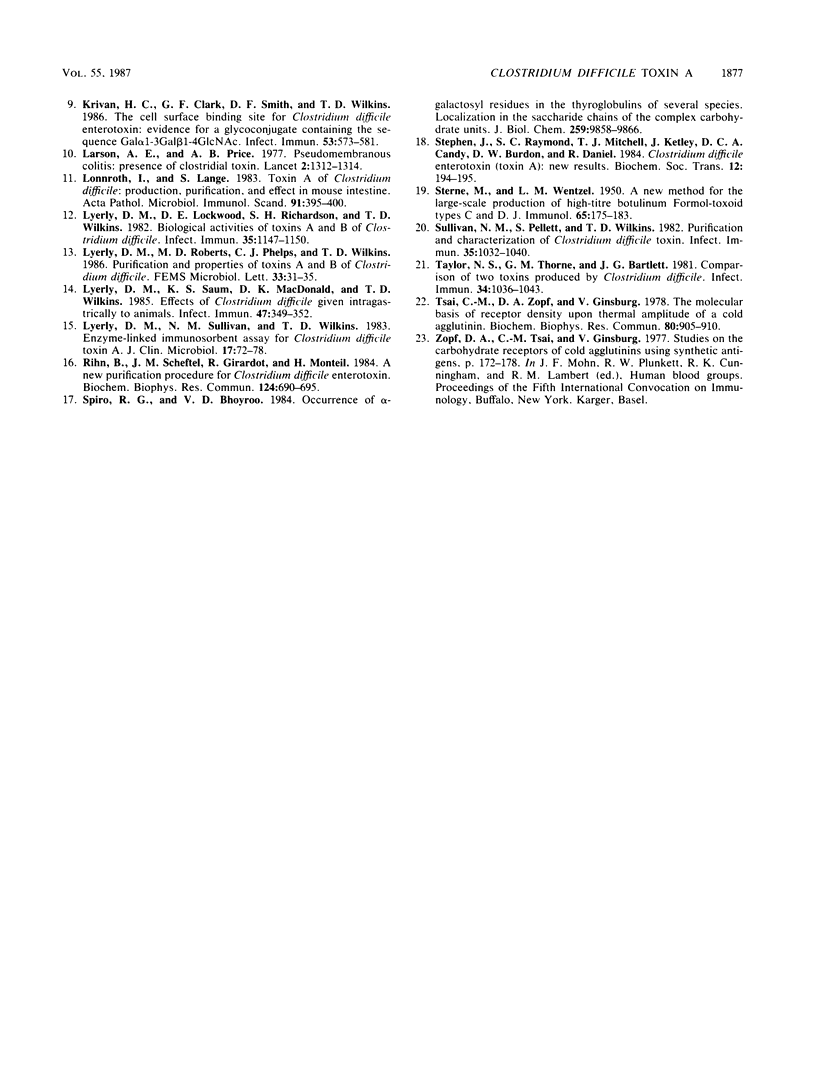Abstract
An efficient, single-step method for isolating highly purified toxin A from Clostridium difficile culture filtrates is described. The purification procedure was based on the affinity binding and release of toxin A to bovine thyroglobulin conjugated to agarose beads. The toxin strongly bound at 4 degrees C to the carbohydrate binding determinant Gal alpha 1-3Gal beta 1-4GlcNAc, a carbohydrate sequence which occurs on bovine thyroglobulin. Toxin bound to thyroglobulin at 4 degrees C, allowing its separation from the culture filtrate and contaminating proteins during the purification scheme. The toxin was eluted by increasing the temperature to 37 degrees C. The toxin-binding capacity was related to the amount of thyroglobulin immobilized on the gel: an affinity column containing 15 mg of bovine thyroglobulin per ml of gel bound 0.53 mg of toxin A per ml of gel. The percent recovery of purified toxin ranged from 56 to 80% and was inversely related to the amount of thyroglobulin coupled to the gel. The affinity-purified toxin was homogeneous as judged by crossed immunoelectrophoresis and gradient polyacrylamide gel electrophoresis and was immunologically identical to toxin A purified by conventional methods as determined by immunodiffusion analysis. The biochemical, hemagglutinating, and toxic properties of the toxin were preserved after affinity chromatography and were comparable with those of toxin A purified by conventional methods.
Full text
PDF




Images in this article
Selected References
These references are in PubMed. This may not be the complete list of references from this article.
- Banno Y., Kobayashi T., Kono H., Watanabe K., Ueno K., Nozawa Y. Biochemical characterization and biologic actions of two toxins (D-1 and D-2) from Clostridium difficile. Rev Infect Dis. 1984 Mar-Apr;6 (Suppl 1):S11–S20. doi: 10.1093/clinids/6.supplement_1.s11. [DOI] [PubMed] [Google Scholar]
- Bartlett J. G., Chang T. W., Gurwith M., Gorbach S. L., Onderdonk A. B. Antibiotic-associated pseudomembranous colitis due to toxin-producing clostridia. N Engl J Med. 1978 Mar 9;298(10):531–534. doi: 10.1056/NEJM197803092981003. [DOI] [PubMed] [Google Scholar]
- Bradford M. M. A rapid and sensitive method for the quantitation of microgram quantities of protein utilizing the principle of protein-dye binding. Anal Biochem. 1976 May 7;72:248–254. doi: 10.1006/abio.1976.9999. [DOI] [PubMed] [Google Scholar]
- Donta S. T., Sullivan N., Wilkins T. D. Differential effects of Clostridium difficile toxins on tissue-cultured cells. J Clin Microbiol. 1982 Jun;15(6):1157–1158. doi: 10.1128/jcm.15.6.1157-1158.1982. [DOI] [PMC free article] [PubMed] [Google Scholar]
- Ehrich M., Van Tassell R. L., Libby J. M., Wilkins T. D. Production of Clostridium difficile antitoxin. Infect Immun. 1980 Jun;28(3):1041–1043. doi: 10.1128/iai.28.3.1041-1043.1980. [DOI] [PMC free article] [PubMed] [Google Scholar]
- Hanfland P., Egge H., Dabrowski U., Kuhn S., Roelcke D., Dabrowski J. Isolation and characterization of an I-active ceramide decasaccharide from rabbit erythrocyte membranes. Biochemistry. 1981 Sep 1;20(18):5310–5319. doi: 10.1021/bi00521a034. [DOI] [PubMed] [Google Scholar]
- Krivan H. C., Clark G. F., Smith D. F., Wilkins T. D. Cell surface binding site for Clostridium difficile enterotoxin: evidence for a glycoconjugate containing the sequence Gal alpha 1-3Gal beta 1-4GlcNAc. Infect Immun. 1986 Sep;53(3):573–581. doi: 10.1128/iai.53.3.573-581.1986. [DOI] [PMC free article] [PubMed] [Google Scholar]
- Larson H. E., Price A. B. Pseudomembranous colitis: Presence of clostridial toxin. Lancet. 1977 Dec 24;2(8052-8053):1312–1314. doi: 10.1016/s0140-6736(77)90363-4. [DOI] [PubMed] [Google Scholar]
- Lyerly D. M., Lockwood D. E., Richardson S. H., Wilkins T. D. Biological activities of toxins A and B of Clostridium difficile. Infect Immun. 1982 Mar;35(3):1147–1150. doi: 10.1128/iai.35.3.1147-1150.1982. [DOI] [PMC free article] [PubMed] [Google Scholar]
- Lyerly D. M., Saum K. E., MacDonald D. K., Wilkins T. D. Effects of Clostridium difficile toxins given intragastrically to animals. Infect Immun. 1985 Feb;47(2):349–352. doi: 10.1128/iai.47.2.349-352.1985. [DOI] [PMC free article] [PubMed] [Google Scholar]
- Lyerly D. M., Sullivan N. M., Wilkins T. D. Enzyme-linked immunosorbent assay for Clostridium difficile toxin A. J Clin Microbiol. 1983 Jan;17(1):72–78. doi: 10.1128/jcm.17.1.72-78.1983. [DOI] [PMC free article] [PubMed] [Google Scholar]
- Lönnroth I., Lange S. Toxin A of Clostridium difficile: production, purification and effect in mouse intestine. Acta Pathol Microbiol Immunol Scand B. 1983 Dec;91(6):395–400. doi: 10.1111/j.1699-0463.1983.tb00066.x. [DOI] [PubMed] [Google Scholar]
- Rihn B., Scheftel J. M., Girardot R., Monteil H. A new purification procedure for Clostridium difficile enterotoxin. Biochem Biophys Res Commun. 1984 Nov 14;124(3):690–695. doi: 10.1016/0006-291x(84)91013-1. [DOI] [PubMed] [Google Scholar]
- STERNE M., WENTZEL L. M. A new method for the large-scale production of high-titre botulinum formol-toxoid types C and D. J Immunol. 1950 Aug;65(2):175–183. [PubMed] [Google Scholar]
- Spiro R. G., Bhoyroo V. D. Occurrence of alpha-D-galactosyl residues in the thyroglobulins from several species. Localization in the saccharide chains of the complex carbohydrate units. J Biol Chem. 1984 Aug 10;259(15):9858–9866. [PubMed] [Google Scholar]
- Stephen J., Redmond S. C., Mitchell T. J., Ketley J., Candy D. C., Burdon D. W., Daniel R. Clostridium difficile enterotoxin (toxin A): new results. Biochem Soc Trans. 1984 Apr;12(2):194–195. doi: 10.1042/bst0120194. [DOI] [PubMed] [Google Scholar]
- Sullivan N. M., Pellett S., Wilkins T. D. Purification and characterization of toxins A and B of Clostridium difficile. Infect Immun. 1982 Mar;35(3):1032–1040. doi: 10.1128/iai.35.3.1032-1040.1982. [DOI] [PMC free article] [PubMed] [Google Scholar]
- Taylor N. S., Thorne G. M., Bartlett J. G. Comparison of two toxins produced by Clostridium difficile. Infect Immun. 1981 Dec;34(3):1036–1043. doi: 10.1128/iai.34.3.1036-1043.1981. [DOI] [PMC free article] [PubMed] [Google Scholar]
- Tsai C. M., Zopf D. A., Ginsburg V. The molecular basis for cold agglutination: effect of receptor density upon thermal amplitude of a cold agglutinin. Biochem Biophys Res Commun. 1978 Feb 28;80(4):905–910. doi: 10.1016/0006-291x(78)91330-x. [DOI] [PubMed] [Google Scholar]





